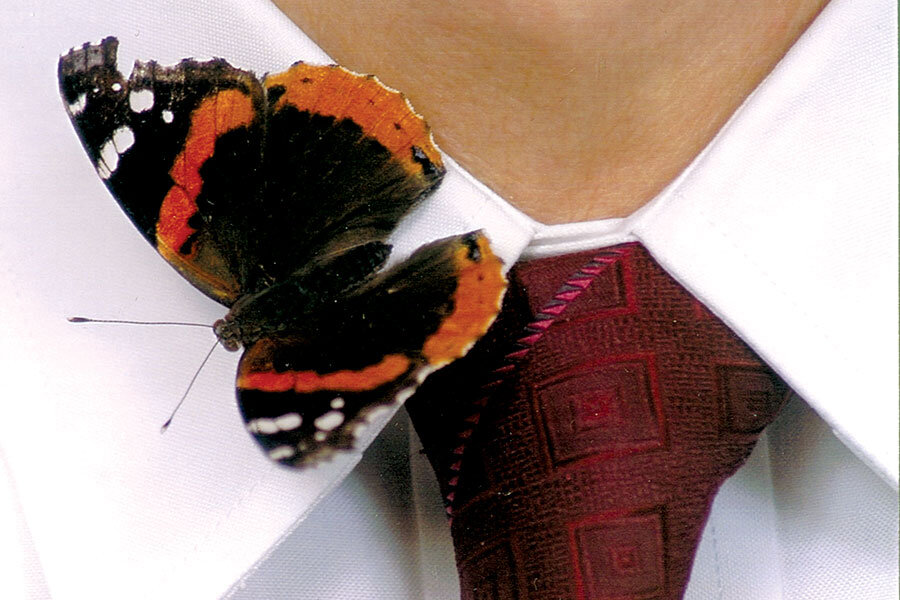Dances with butterflies
Loading...
Since 2007 I’ve developed a friendship with a butterfly. A particular kind of butterfly, that is: the red admiral (Vanessa atalanta). It is among the most common and most friendly butterflies. It’s not unusual to have one land on you.
But the first of these butterflies in my experience lit on my shoulder at an unusual location, for an unusually long time. It was a July afternoon in downtown Washington, D.C. He stayed on me for 30 minutes, even while I stopped at a photo shop and asked to have my picture taken with him (see photo).
Then I took him into a steakhouse across the street and called my wife, Muriel. I told her that I planned to bring the butterfly home with me in a taxi.
The restaurant was filling up as 6 p.m. approached. The manager searched online for what butterflies liked to eat: overripe fruit. But the insect ignored the strawberries she offered.
I knew almost nothing about butterflies. I had a few notions about monarchs and their migrations. My new friend looked nothing like a monarch. He was mostly black with orange bands on his wings. His wingspan was a little more than two inches.
From the start, this small fragile creature brought out the best in people, even in the unlikely setting of a restaurant filled with dark wood and brass trim. People at nearby tables smiled and spoke softly as they watched the butterfly. They seemed to sense that something special was happening.
With the butterfly still on my shoulder, I paid the bill. Then, out on M Street, I hailed a cab.
Once we arrived home, I called in two of our neighbors as witnesses. Liz said that the butterfly was trying to tell me to stop working late and to “pay attention to what’s really important in life.” Gina pronounced the butterfly a reincarnation.
I thought that was the end of it. But when I returned home the following day, Muriel exclaimed, “He’s back!”
She had spotted the insect among the cascading leaves of our cherry tree. For more than a month, the butterfly – that I now called Poppy – appeared whenever I returned home before dark, making 25 visits altogether, and often landing on me. Other red admirals quickly joined Poppy in our garden. I had never seen this species before. Now they seemed to be everywhere.
I consulted Bob Robbins, curator of Lepidoptera (butterflies and moths) for the Smithsonian Institution. He suggested that Poppy might have been attracted to my sweat and found that I was a good perch from which to look for female butterflies.
But Mr. Robbins also found it odd that for more than a month this particular butterfly had visited me almost every evening.
For the next two summers I waited in vain for more visits.
Then on July 4, 2010, during the celebration of my mother-in-law’s birthday, two red admirals appeared in her garden in St. Paul, Minn. They landed on my shoulders. We took pictures.
After Muriel and I returned home, she spotted another butterfly above our roof. His landings continued well into August.
Then on Aug. 16 last year, a butterfly made the most auspicious arrival of all. Two days before our daughter’s wedding in Purchase, N.Y., Muriel told me that two red admirals were hovering over our parked car.
The day before the wedding, I sat near the car where my wife had seen the butterflies. One red admiral landed in front of me and opened and closed its wings for about 10 minutes.
In researching these encounters, I found they were not unique. Thanks to a tip from an amateur lepidopterist, I learned that red admirals had landed on a boy in California for three consecutive summers from 1969 until 1971. But in my case, the butterflies came to me in several regions and for longer periods.
It’s important to note that I had a lot of help from my wife. It was Muriel who nearly always spotted the butterflies first. It’s not surprising; Muriel sees things in nature that I regularly miss.
I’ve been touched by the reactions of friends and neighbors as well as strangers charmed by my butterfly encounters. People tell me their own stories about friendly birds or other animals.
And just the other evening, two red admirals circled around me in our garden. One landed on my head and shoulders on and off for more than 30 minutes.
What does it all mean? Seven years ago, after the first butterfly landed on me, I thought that a small impossibility had occurred. But given all that has happened since, I feel as though I’ve made a connection. I’m being blessed by butterflies.
The author, now executive editor of Radio Free Asia, had long careers as a correspondent for the Monitor and The Washington Post.







